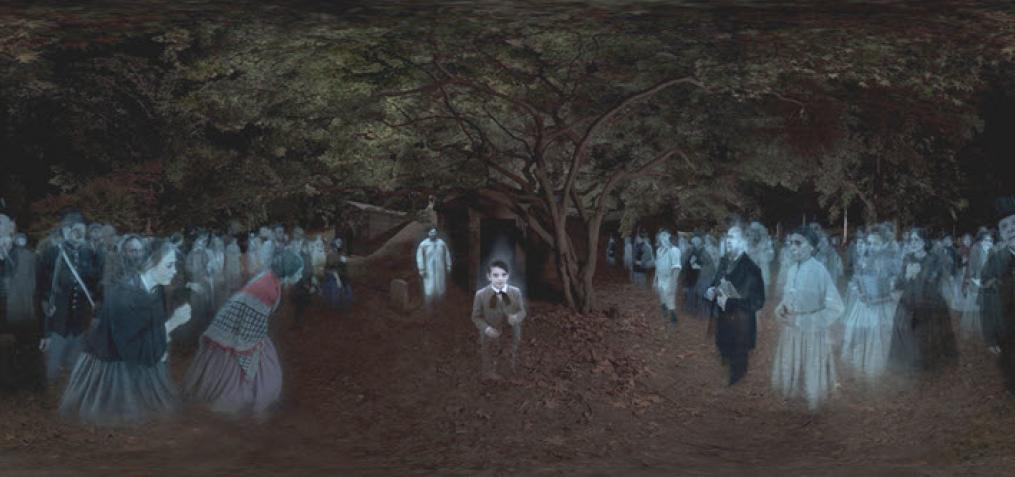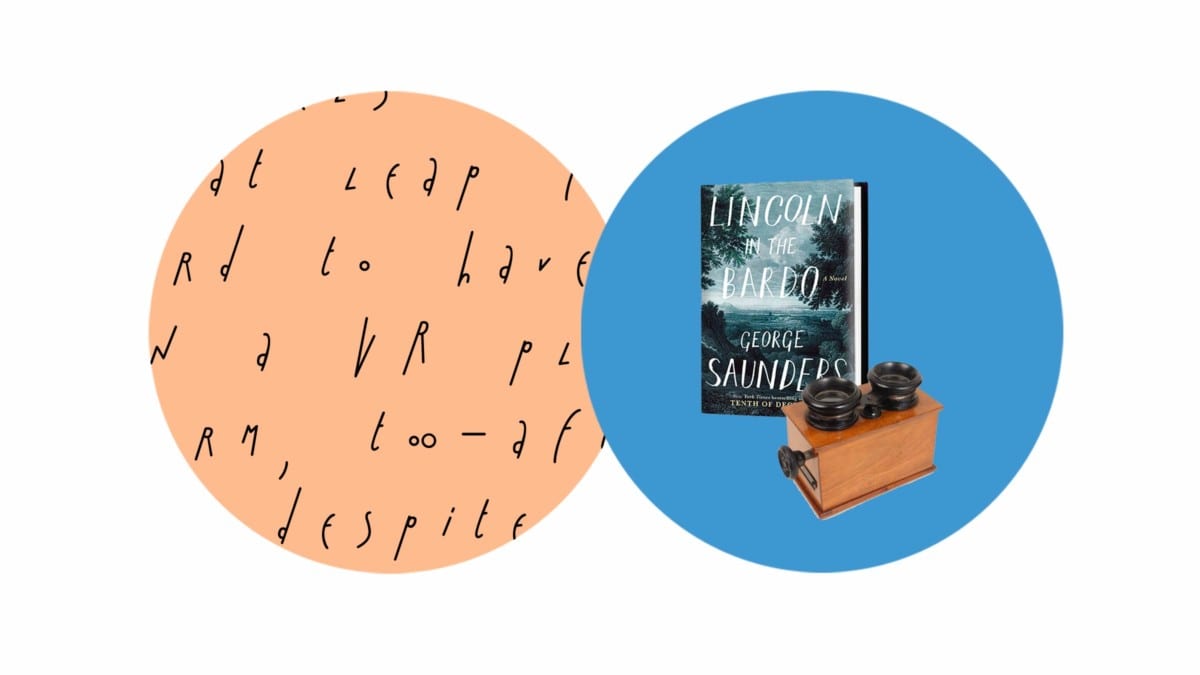VR owes much of its storytelling potential to the power of place. A strong medium for ambient experience, VR has the ability to play with a viewer’s relationship to virtual surroundings using preexisting impressions of real world spaces. An old graveyard in the dead of night, for instance, comes loaded with a certain amount of significance and mood—grief, unease, solitude. This place and all of its associations constitute the setting of the New York Times-backed VR experience Lincoln in the Bardo, directed by Graham Sack and based on the first novel by beloved short fiction author George Saunders.
When you work in publishing, as I do, a book like this one is enough of an event in itself. Already featured in every media outlet with literary sensibilities, it feels like a great leap forward to have it on a VR platform, too—after all, despite obvious differences, books and VR are alike in their introversion. Saunders sets the novel in a cemetery over the course of one night in 1862, as President Lincoln mourns the death of his young son Willie. This simplicity works to Sack’s advantage. As the audiobook version—a dramatic reading of 166 voices, whose cast includes famous actors as well as Saunders’ family and friends—makes evident, the book already reads somewhat like a play. As such, it’s prime for VR, which is more conducive to theater’s steady continuity than to the frequent cuts and camera movements now customary in movies and TV.
In Sack’s cemetery, Willie is the first ghost we meet; the second (and spookiest) is a Civil War soldier clutching his severed right arm in his left hand. They speak directly to the viewer, and more apparitions continue to surface on all sides, layering voices and cutting each other off while trying to tell their own stories. About three and a half minutes in, Lincoln—alone among the living—enters, takes his son’s body from its tomb and, holding him, delivers a soliloquy. Here the experience reached its most arresting moment for me, but not because of Lincoln—though during his entrance and initial dialogue, I was inclined to follow his every move. When I turned away from Lincoln’s speech, I found a huge crowd of ghosts assembled opposite him, silently watching. In the headset, this moment is intensely effective, a suddenly slippery muddle of real and unreal. I got goosebumps and felt as though ghosts—nebulous presences that they are—were surrounding me in my living room. In the VR world, where the spirits remain invisible to Lincoln, I also felt like one of them.

At a duration of 10 minutes, Lincoln in the Bardo VR runs a little too long for the format. Though it looks impressively crisp on YouTube, a simple headset like the Google Cardboard can’t be refocused to prevent a blurry image and its resulting visual fatigue. Even so, as the first book-adjacent VR I’ve encountered, it sets a very high bar for future endeavors in these kinds of literary pairings. As a marketing stunt, it’s bound to be viewed with some trepidation in an industry that has struggled to keep pace with the digital, visual age.
The team behind the VR stresses that it’s a “companion piece,” rather than a commercial for the book (the latter would, in theory, be much shorter and feel incomplete in its narrative). But whether you call it a commercial or not, it can do the job of one: thanks to the VR, I spent enough time thinking and reading about the novel that I ultimately purchased it. This kind of cause-and-effect of what drives a reader to buy a book is not great material for for measurement and analysis, but it has anecdotal value for a publisher considering its customers. I like the term “companion piece” in conceptualizing ways to broaden the industry’s ambitions in content marketing.
In the face of book VR I can’t help but think about book trailers, an undying phenomenon in publishing that has never fully arrived. No matter how simple the concept, a quality two-minute video takes time, talent, and money; for this reason, most book trailers land somewhere on the spectrum of mediocre to awful, thus seeming unnecessary or even detrimental to the books they’re intended to promote. I have seen exceptions, including one by Jamieson Fry (from 2010) for T. C. Boyle’s novel The Women. Like Lincoln in the Bardo, the trailer is cast with actors in period costume. That it plays out with almost no dialogue—except for four utterances of the name “Frank”—against the audio of one striking, dramatic song works very much to its advantage. It looks and sounds like a teaser for a real movie in its remarkably high production value, even showcasing the architectural style of Frank Lloyd Wright, the book’s subject. More recently, Universal Harvester, the second book from Mountain Goats’ frontman John Darnielle, garnered enough anticipation to warrant a BuzzFeed reveal of a book trailer directed by Andrew Bruntel. The trailer hits a desirable mark in its avoidance of casting any characters, leaving them to the future reader’s imagination. Mysterious and chilling, it establishes strong sense of place, sets a mood, and most importantly, makes you want to know the full story. Darnielle’s perfectly paced voiceover narration manifests the merits of listening to writing read aloud by its author.
Book trailers, VR companion pieces, and the like might be easily dismissed as a gimmicky marketing ploy with a dubious reach (as far as less-than-astronomical YouTube views indicate). It’s true they have nothing to do with what makes lasting literature. Still, new books worthy of attention need increasingly creative marketing in order to stand out from the noise. Publishers—historically reluctant to upgrade and adapt—might lament at having to compete with each other outside of the printed medium, but at the end of the day, it doesn’t hurt to have a book title and author represented on YouTube, the world’s second largest search engine. VR experiences like Lincoln in the Bardo open up even more possibilities for immersing an audience. A good book will, of course, always stand on its own.
*Lincoln in the Bardo can be viewed on YouTube, but I recommend using a headset (with the New York Times VR app) for the full experience.
